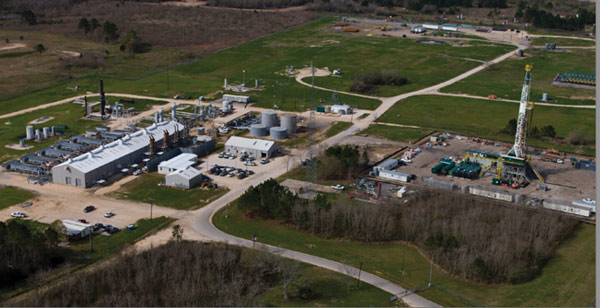
A better way to manage assets
By Steve Gahbauer
Facilities Maintenance Industry Operations Manufacturing Asset Management maintenance manufacturing Plant Engineering and Maintenance Association of Canada (PEMAC)Union Gas achieves excellence in Sarnia.

An aerial view of the Union Gas storage and transmission facility near Sarnia, Ont. PHOTO: UNION GAS
Achieving excellence in maintenance is a journey. It begins with a soul-searching look at practices, setting goals for improvement and forming a team to carry out the transformation from having few documented processes and a heavy reliance on “tribal” knowledge to structured management processes.
A description of such a journey was presented at a MainTrain conference, convened by the Plant Engineering and Maintenance Association of Canada (PEMAC).
Mike Hildebrand, manager of storage and transmission operations, process improvement and planning at Ontario’s Union Gas Ltd., and Terry Taylor, a senior maintenance and reliability management consultant with IDCON Inc., in Raleigh, NC, gave an account of what Union Gas experienced during its journey to excellence.
Over several years the maintenance group at Union Gas Storage and Transmission Operations (STO) near Sarnia, Ont. experienced many challenges while completing annual maintenance plans. The maintenance culture was mostly reactive. There was little to no coordination among the various crafts as they completed their work; more focus was needed on the management and lifecycle of assets; and there were disparate applications used by different groups throughout the company to rationalize. These factors led to the launch of the Maintenance Excellence Project, which became the foundation for a corporate-wide asset management strategy.
In early 2012, IDCON conducted a current best practices assessment, a rigorous and lengthy evaluation process. Interviews were held with 30 to 40 workers from various maintenance, operations and other support groups, such as supply chain, warehousing and engineering.
The other significant driver for change was the anticipated rationalization of all asset-related applications into one enterprise asset management (EAM) system – SAP Plant Maintenance. Significant work was anticipated because documentation was weak, resulting in a heavy reliance on historical knowledge to get work done.
Managing change
A detailed action plan addressed the higher priority issues with a project charter to ensure deliverables and timelines was created and a project manager was assigned to ensure the team stayed focused on them.
A lead was assigned to each major track, and regular team meetings were held to maintain contact. The project manager also handled change management and communications to all levels of the organization.
Documentation of business processes for planning and scheduling followed the basic “identify-plan-schedule-execute-close and analyze” (IPSECA) process. The starting point was “Best Practice Processes” provided by IDCON. From these, the standard Union Gas process methodology was adopted, using swim lane-type maps to clearly identify roles and responsibilities.
IDCON identified a lack of maintenance planning and scheduling functions. Individual supervisors managed them, working in isolation from the other crews and crafts. A maintenance coordinator was needed, starting with one role planning and scheduling work for three mechanical maintenance crews. A pilot implementation tested its suitability for extension through the rest of the organization.
On-site coaching and technical training was provided to all of the key stakeholders, followed by on-the-job training and coaching. IDCON recorded observations and capitalized on some key coaching opportunities with maintenance coordinators and supervisors to illustrate the key principles of work management.
Next up were new planning and scheduling processes, which began with one crew of six mechanics.
The top three most critical facilities across STO were tackled first. Cross-functional teams of mechanics, technicians and engineers were brought together to develop optimized maintenance programs. Full-day sessions held as close to the site as possible provided easy access to equipment and the review of specifics related to accessibility for inspection and maintenance.
Continuous review and monitoring has been a critical component of the rollout. Through the first year, several basic measures were tracked, including hours charged to work orders and weekly schedule compliance, two important behaviours that are leading indicators for reliability.
Among the final deliverables was a roadmap developed and assembled by a group of frontline workers and managers that prioritized all of the initiatives.
Union Gas demonstrated that significant benefits result from gathering diverse opinions from all levels of an organization, and that clear, realistic and measurable objectives are ensure goals are accomplished.
Steve Gahbauer is an engineer, a Toronto-based business writer and a regular contributing editor to PLANT.
